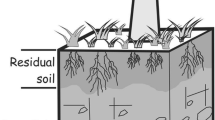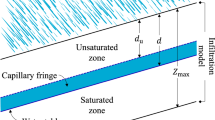Abstract
Shallow landslides induced by heavy rainfall events represent one of the most disastrous hazards in mountainous regions because of their high frequency and rapid mobility. Recent advancements in the availability and accessibility of remote sensing data, including topography, land cover and precipitation products, allow landslide hazard assessment to be considered at larger spatial scales. A theoretical framework for a landslide forecasting system was prototyped in this study using several remotely sensed and surface parameters. The applied physical model SLope-Infiltration-Distributed Equilibrium (SLIDE) takes into account some simplified hypotheses on water infiltration and defines a direct relation between factor of safety and the rainfall depth on an infinite slope. This prototype model is applied to a case study in Honduras during Hurricane Mitch in 1998. Two study areas were selected where a high density of shallow landslides occurred, covering approximately 1,200 km2. The results were quantitatively evaluated using landslide inventory data compiled by the United States Geological Survey (USGS) following Hurricane Mitch’s landfall. The agreement between the SLIDE modeling results and landslide observations demonstrates good predictive skill and suggests that this framework could serve as a potential tool for the future early landslide warning systems. Results show that within the two study areas, the values of rates of successful estimation of slope failure locations reached as high as 78 and 75%, while the error indices were 35 and 49%. Despite positive model performance, the SLIDE model is limited by several assumptions including using general parameter calibration rather than in situ tests and neglecting geologic information. Advantages and limitations of this physically based model are discussed with respect to future applications of landslide assessment and prediction over large scales.







Similar content being viewed by others
References
Baum RL, Savage WZ, Godt JW (2002) TRIGR—a Fortran program for transient rainfall infiltration and grid-based regional slope-stability analysis. U.S. Geological Survey Open File Report
Boebel O, Kindermann L, Klinck H, Bornemann H, Plotz J, Steinhage D, Riedel S, Burkhardt E (2006) Satellite remote sensing for global landslide monitoring. EOS (Transactions, American Geophysical Union) 87(37):357–358
Claessens L, Heuvelink GBM, Schoorl JM, Veldkamp A (2005) DEM resolution effects on shallow landslide hazard and soil redistribution modelling. Earth Surf Process Landf 30(4):461
Dai EC, Lee CF, Nagi YY (2002) Landslide risk assessment and management: an overview. Eng Geol 64:65–87
Dietrich WE, Reiss R, Hsu ML, Montgomery DR (1995) A process-based model for colluvial soil depth and shallow landsliding using digital elevation data. Hydrol Process 9:383–400
Ebel BA, Loague K, Montgomery DR, Dietrich WE (2008) Physics-based continuous simulation of long-term near-surface hydrologic response for the Coos Bay experimental catchment. Water Resour Res 44:W07417. doi:10.1029/2007WR006442
Fawcett T (2006) An introduction to ROC analysis. Pattern Recogn Lett 27:861–874
Godt JW, Baum RL, Lu N (2009) Landsliding in partially saturated materials. Geophys Res Lett 36:L02403
Hansen MC, DeFries RS, Townshend JRG, Sohlberg R (2000) Global land cover classification at 1 km spatial resolution using a classification tree approach. Int J Remote Sens 21(6 & 7):1331–1364
Harp EL, Hagaman KW, Held MD, McKenna JP (2002) Digital inventory of landslides and related deposits in Honduras Triggered by Hurricane Mitch, U.S. Geological Survey Open-File Report 02-61
Hong Y, Adler RF (2007) Towards an early-warning system for global landslides triggered by rainfall and earthquake. Int J Remote Sens 28(16):3713–3719
Hong Y, Adler R, Huffman G (2006) Evaluation of the potential of NASA multi-satellite precipitation analysis in global landslide hazard assessment. Geophys Res Lett 33:L22402. doi:10.1029/2006GRL028010
Hong Y, Adler R, Huffman G, Negri A (2007) Use of satellite remote sensing data in mapping of global shallow landslides susceptibility. J Nat Hazards 43(2). doi:10.1007/s11069-006-9104-z
Huffman GJ, Adler RF, Bolvin DT, Gu G, Nelkin EJ, Bowman KP, Hong Y, Stocker EF, Wolff DB (2007) The TRMM Multisatellite Precipitation Analysis (TMPA): quasi-global, multiyear, combined-sensor precipitation estimates at fine scales. J Hydrometeorol 8:38–55. doi:10.1175/JHM560.1
Iverson RM (2000) Landslide triggering by rain infiltration. Water Resour Res 36(7):1897–1910
Kirschbaum, DB, Adler R, Hong Y, Hill S, Lerner-Lam A (2010) A global landslide catalog for hazard applications—method, results and limitations. J Nat Hazards 52(3):561–575. doi:10.1007/s11069-009-9401-4
Kirschbaum DB, Adler R, Hong Y, Peters-Lidard C, Lerner-Lam A (2011) Advances in landslide hazard forcasting: evaluation of a global and regional modeling approach. Environ Earth Sci (in press)
Liao Z, Hong Y, Wang J, Fukuoka H, Sassa K, Karnawati D, Fathani F (2010) Prototyping an experimental early warning system for rainfall-induced landslides in Indonesia using satellite remote sensing and geospatial datasets. ICL Landslides J 7(3):317–324. doi:10.1007/s10346-010-0219-7
Lu N, Godt JW (2008) Infinite slope stability under unsaturated seepage conditions. Water Resour Res 44:W11404. doi:10.1029/2008/WR006976
Montrasio L, Valentino R (2008) A model for triggering mechanisms of shallow landslides. Nat Hazards Earth Syst Sci 8:1149–1159
Nadim F, Kjekstad O, Peduzzi P, Herold C, Jaedicke C (2006) Global landslide and avalanche hotspots. Landslides 3:159–173
Schmidt KM, Roering JJ, Stock JD, Dietrich WE, Montgomery DR, Schaub T (2001) The variability of root cohesion as an influence on shallow landslide susceptibility in the Oregon Coast Range. Can Geotech J 38:995–1024
Sidle RC, Ochiai H (2006) Landslides: processes, prediction, and land use. AGU, Washington, DC
Sorbino G, Sica C, Cascini L (2010) Susceptibility analysis of shallow landslides source areas using physically based models. Nat Hazards 53:313–332
Waldron LJ, Dakessian S, Nemson JA (1983) Shear resistance enhancement of 1.22-meter diameter soil cross sections by pine and alfalfa roots. Soil Sci Soc Am J 47:9–14
Wu W, Sidle RC (1995) A distributed slope stability model for steep forested basins. Water Resour Res 31:2097–2110
Zhang W, Montgomery DR (1994) Digital elevation model grid size, landscape representation, and hydrologic simulations. Water Resour Res 30(4):1019–1028. doi:10.1029/93WR03553
Acknowledgments
The computing for this project was performed at the OU Supercomputing Center for Education & Research (OSCER) at the University of Oklahoma (OU). This research was supported by an appointment to the NASA Postdoctoral Program at the Goddard Space Flight Center, administered by Oak Ridge Associated Universities through a contract with NASA. The authors would also like to extend the appreciations to USGS scientists make the landslide inventory data available for research community.
Author information
Authors and Affiliations
Corresponding author
Rights and permissions
About this article
Cite this article
Liao, Z., Hong, Y., Kirschbaum, D. et al. Assessment of shallow landslides from Hurricane Mitch in central America using a physically based model. Environ Earth Sci 66, 1697–1705 (2012). https://doi.org/10.1007/s12665-011-0997-9
Received:
Accepted:
Published:
Issue Date:
DOI: https://doi.org/10.1007/s12665-011-0997-9




